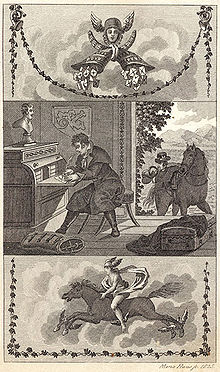Letter holder
A letter holder is a book that gives instructions on how to write letters - a type of text that became particularly important to the student audience in the 17th and 18th centuries.
history
Titulature was cultivated more strongly in the German-speaking countries than in French and English (Johann Leonhard Rost's letter from 1713 offers detailed observations on this, as well as an overview of the market). People had to be correctly addressed and addressed according to the status. Today this tradition can only be felt in the academic community and in the church (with salutations like Spectabilis for the dean of a university).
Beyond the title, it was necessary to separate the letters according to different tasks into letters of application, letters of introduction, suppliques (petition letters) etc., which in turn had to be differentiated according to occasion and contact person.
Finally, the correct sequence of steps had to be observed in the letter - opening, raising the matter in its respective points, and so on.
At the end of the 17th century, with the advent of the gallant conduite, the production of letter carriers became a fashionable and fashionable business. The leading novelists published one after the other from August Bohse to Christian Friedrich Hunold to Johann Leonhard Rost , in which they used the market as masters of the current style. August Bohse lived in the 1680s and 1690s from courses that he offered alongside his publications. However, priority was given to Hunold alias Menantes with letter carriers that underwent some modifications in the first two decades of the 18th century and that attracted customers in the first editions, as the author also interspersed the "mixed letters" with those that he wrote or wrote himself had received what gave interested parties first insights into the life of the scandal-ridden novel and opera writer. Rost alias Meletaon limited himself in the competition with his two titles 1713 and 1716 to the more practical and more fundamental instruction; in retrospect, the introductions to the book from 1713 are particularly interesting here.
The genre fell out of fashion again in the mid-18th century. Instructions for letters and the necessary formalities still had to and must be given regardless of this, and can still be found in etiquette guides and books that give instructions for specific life situations - a broad market of guide books today provides samples of perfect application folders and cover letters. Own courses offer lessons in the field. The word letter holder became the generic term for the lost production, in which strict formalities applied, while in today's competitive situation the impression of (self) representation counts above all.
Selected titles
- August Bohse : Thorough introduction to German Teutsche Letters. Jena 1706 (reprint: Scriptor, Kronberg 1974).
- Christian Friedrich Hunold : The very latest way of writing politely and gallantly, or exquisite letters [...] from Menantes . G. Liebernickel, Hamburg 1707.
- Johann Leonhard Rost : The newly opened German letter cabinet [...] by Meletaon . J. Chr. Lochner, Nuremberg 1713.
- Johann Wilhelm Schaubert: Instructions for regular writing of German letters [...]. Th. Wilh. Ernst Güth, Jena 1751.
- Gottfried Schmotther: From the epistolographia or the internal and external quality of a decent letter to high and low people [...] . Dresden 1752 ( digitized version ).
- The art of producing German letters, along with orthographic lectures . Glogau 1775 ( digitized version ).
- Benedikt G. Schäfler: Collection of well-arranged letters for all common cases . Rieger, Augsburg 1780 ( digitized version ).
- Johann Georg Müller: The latest letter writer for all occasions in common life. In addition to instructions to produce business essays . Anton Doll, Vienna 1801 ( digitized version (PDF; 7.3 MB) ( Memento from September 27, 2007 in the Internet Archive )).
- Alois Josef Ruckert: Letter holder for elementary and advanced schools. Instructions for correct letter writing with more than 200 written letters and business essays . Wilhelm Keller, Würzburg 1875 ( digitized version ; selected e-texts ( memento from September 29, 2007 in the Internet Archive )).
- Duden editorial team: Writing letters - made easy. The guide to writing business and private letters and e-mails. With lots of instructions and sample letters . Dudenverlag, Mannheim et al. 2003, ISBN 3-411-05554-5 .
literature
- Carolin Antes: The forgotten letter plates of the 19th century. A bibliography from 1800 to 1880. Werhahn, Hannover 2016, ISBN 978-3-86525-484-9 .
- Carmen Furger: Letter holder. The medium "letter" in the 17th and early 18th centuries. Böhlau, Cologne et al. 2010, ISBN 978-3-412-20420-4 .
- Reinhard MG Nickisch : The style principles in the German letter writers of the 17th and 18th centuries. With a bibliography on letter writing theory (1474–1800). Vandenhoeck and Ruprecht, Göttingen 1969.
- Robert Vellusig: Written Conversations. Letter culture in the 18th century (= literature and life. Vol. 54). Böhlau, Vienna et al. 2000, ISBN 3-205-99205-9 .
Web links
- Bibliography of German language guides (15th – 19th centuries) , contains numerous letters


